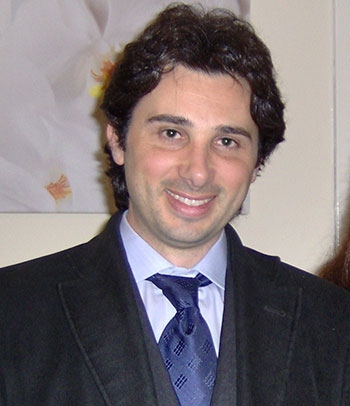Misophonia is defined as an abnormally strong emotional and behavioral reaction to particular sounds or groups of sounds that have a specific pattern and meaning to the patient (Jastreboff & Jastreboff 2003), although a consensus paper bringing together experts from a wide range of disciplines suggested using the term “annoyance hyperacusis” for the experience of negative emotional reaction to sound (Tyler et al. 2014). Andrea E. Cavanna (Department of Neuropsychiatry, Birmingham, UK) discussed the possible mechanisms underlying misophonia.

Professor Andrea E. Cavanna
Although misophonia is not listed in any major psychiatric classification system, a few psychiatric clinics have reported treating patients with misophonia (Bernstein et al. 2013; McGuire et al. 2015; Schroder et al. 2013; Webber et al. 2014). Systematic studies of misophonia are very limited (Cavanna & Seri 2015). In the field of psychiatry, there is a growing debate as to whether misophonia is a distinct psychiatric disorder or a variety of hyperacusis that is often co-morbid with neuropsychiatric disorders (Cavanna 2014; Cavanna & Seri 2015; Neal & Cavanna 2013; Schroder et al. 2013; Taylor 2017). Specifically, neuro-developmental disorders including Tourette syndrome (Cavanna & Seri 2013) and autism spectrum disorder (see the following section) have been shown to be associated with misophonia in a proportion of cases, suggesting shared neuro-developmental trajectories.
Most research studies in the field of audiology have not distinguished misophonia from hyperacusis (Andersson et al. 2002; Fackrell et al. 2015; Juris et al. 2014; Schecklmann et al. 2014; Schecklmann et al. 2015; Sheldrake et al. 2015; Zaugg et al. 2016). Jastreboff and Jastreboff (2015) reported that people with severe hyperacusis always experience misophonia. Recent studies conducted within the National Health Service (NHS) in the UK suggest that severe hyperacusis is typically characterized by strong across-frequency variations in sensitivity to sound, which is an indication of adverse reaction only to specific sounds, a feature that is associated with misophonia (Aazh & Moore 2017; Aazh & Moore 2018).
Based on the above mentioned studies, it is likely that misophonia forms part of the spectrum of hyperacusis and needs to be considered when assessing patients with sound intolerance complaints.
Dr. Hashir Aazh

References
Aazh, H., & Moore, B. C. J. (2017).
Factors related to Uncomfortable Loudness Levels for patients seen in a tinnitus and hyperacusis clinic.
International Journal of Audiology 56, 793-800.
Aazh, H., & Moore, B. C. J. (2018).
Prevalence and characteristics of patients with severe hyperacusis among patients seen in a tinnitus and hyperacusis clinic
Journal of American Academy of Audiology, 29, 626-633.
Andersson, G., Lindvall, N., Hursti, T., et al. (2002).
Hypersensitivity to sound (hyperacusis): a prevalence study conducted via the Internet and post.
Int J Audiol, 41, 545-54.
Bernstein, R. E., Angell, K. L., & Dehle, C. M. (2013).
A brief course of cognitive behavioural therapy for the treatment of misophonia: a case example.
The Cognitive Behaviour Therapist, 6, e10.
Cavanna, A. E. (2014).
What is misophonia and how can we treat it?
Expert Rev Neurother, 14, 357-9.
Cavanna, A. E., & Seri, S. (2013).
Tourette’s syndrome.
Bmj, 347, f4964.
Cavanna, A. E., & Seri, S. (2015).
Misophonia: current perspectives.
Neuropsychiatr Dis Treat, 11, 2117-23.
Fackrell, K., Fearnley, C., Hoare, D. J., et al. (2015).
Hyperacusis Questionnaire as a tool for measuring hypersensitivity to sound in a tinnitus research population.
Biomed Res Int, 2015, 290425.
Jastreboff, P. J., & Jastreboff, M. M. (2003).
Tinnitus retraining therapy for patients with tinnitus and decreased sound tolerance.
Otolaryngologic Clinics of North America, 36, 321-336.
Jastreboff, P. J., & Jastreboff, M. M. (2015).
Decreased sound tolerance: hyperacusis, misophonia, diplacousis, and polyacousis.
Handb Clin Neurol, 129, 375-87.
Juris, L., Andersson, G., Larsen, H. C., et al. (2014).
Cognitive behaviour therapy for hyperacusis: A randomized controlled trial.
Behav Res Ther, 54c, 30-37.
McGuire, J. F., Wu, M. S., & Storch, E. A. (2015).
Cognitive-behavioral therapy for 2 youths with misophonia.
J Clin Psychiatry, 76, 573-4.
Neal, M., & Cavanna, A. E. (2013).
Selective sound sensitivity syndrome (misophonia) in a patient with Tourette syndrome.
J Neuropsychiatry Clin Neurosci, 25, E01.
Schecklmann, M., Landgrebe, M., Langguth, B., et al. (2014).
Phenotypic characteristics of hyperacusis in tinnitus.
PLoS One, 9, e86944.
Schecklmann, M., Lehner, A., Schlee, W., et al. (2015).
Validation of Screening Questions for Hyperacusis in Chronic Tinnitus.
Biomed Res Int, 2015, 191479.
Schroder, A., Vulink, N., & Denys, D. (2013).
Misophonia: diagnostic criteria for a new psychiatric disorder.
PLoS One, 8, e54706.
Sheldrake, J., Diehl, P. U., & Schaette, R. (2015).
Audiometric characteristics of hyperacusis patients.
Front Neurol, 6, 105.
Taylor, S. (2017).
Misophonia: A new mental disorder?
Medical Hypotheses 103, 109-117.
Tyler, R. S., Pienkowski, M., Rojas Roncancio, E., et al. (2014).
A review of hyperacusis and future directions: part I. definitions and manifestations.
American Journal of Audiology, 23, 402-419.
Webber, T. A., Johnson, P. L., & Storch, E. A. (2014).
Pediatric misophonia with comorbid obsessive-compulsive spectrum disorders.
Gen Hosp Psychiatry, 36, 231.e1-2.
Zaugg, T. L., Thielman, E. J., Griest, S., et al. (2016).
Subjective Reports of Trouble Tolerating Sound in Daily Life versus Loudness Discomfort Levels.
Am J Audiol, 25, 359-363.

